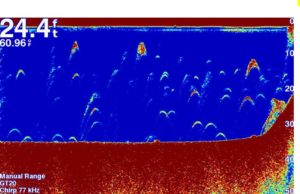
CHIRP is ideal for fishing, and the reason for it is a convenience it brings to the fisher. This can be identified in terms of time and productivity. If you still use the old-age technologies, it’s the right time to shift to CHIRP.
CHIRP technology spends more energy and sends a longer pulse. This helps with a clear depiction of fish in the area. This technology is a game-changer because of the energy frequency variation and easy accessibility.
This technology uses a varying frequency that best fits your fishing needs, thus resulting in improved results. Let’s explore it!
Table of Contents
CHIRP on Fishfinder: An Innovation
CHIRP is a shortened form for ‘Compressed High-Intensity Radar Pulse.’ It is one of the latest additions in sonars for the ease of fishers. Having found its initial use for military purposes, recreational and commercial fishing have now added it for enhanced productivity.
In contrast to simple sonar, CHIRP transmits longer pulses that remain consistent and don’t fade out early. It improves the results in the form of clear images. The main reason for failure of common sonars is their fixed frequency. Better results in CHIRP mean crisp images which help identify the target. If we use common sonar, it will transmit brief signals, and the fisher might not be able to keep an eye on the fish.
The energy it puts to the water column is more than normal sonar, which means that the results will be better. The transducer initially starts with lower energy which gradually modulates to high. The duration of its pulses, named ascending pulses, is 10x to that of traditional sonars. CHIRP’s true broadband frequency range can be high up to 117KHz.
What makes it better in comparison to simple sonar is the tone burst difference. The prior one sends brief signals that might not be of any help to the fisher. They don’t last for long, and this leads to an unclear idea of where the fish is. Often the fisher receives signals which fade out too early, or sometimes the results are not clear. In contrast to traditional sonar, it transmits more energy which is 10 to 60 times of the normal one.
How does a CHIRP work?
CHIRP is placed amongst smart technologies because of pulse compression and pattern correlation. It processes signals using the matching of digital patterns. Thus, it is able to process information from each pulse it receives. This makes it possible to achieve an unmatchable resolution and a clear idea of the target. The resolution is refined by using compression of pulses.
It transforms the amplitude of an extended frequency pulse to the desired pulse. This helps it with the easy identification and translation of results on the screen. It improves the signal quality by enhancing the signal-to-noise ratio. Thus, it makes it possible for the user to identify the target from other objects. The image it processes has a clear differentiation between individual objects.
Types of CHIRP Frequency
As said earlier, CHIRP is ideal for fishers due to the frequency changes that can be made to it. The types of CHIRP frequencies include High, Medium, and Low CHIRP. Each of these is discussed in detail as follows.
High Frequency
High CHIPR ranges from 150 to 240 kHz and is ideal in the range of 600 ft. or less. It can be used in freshwater and inland areas. It can be used for tracking and identification of fish. It can also help track fish near the bottom.
Medium Frequency
This frequency ranges from 80 to 160 kHz and is ideal in a range of depths less than 600 ft. In comparison to high CHIRP, it gives less detailed pictures.
Low Frequency
Ranges from 80 to lower KHz, useful in depths over 600 ft. As evident from the range, it is a deep-water frequency; it tells of the targets at all water depths.
The fisher can choose one of these based on their needs.
The frequency, as mentioned earlier, covers the needs of a fisher. It can enhance efficiency and result in better productivity.
Benefits of CHIRP
Professional and leisure fishers use finders for better results. CHIRP displays results that are not possible in fixed frequency sonars. It has a vast range of frequencies that depict a detailed and accurate depiction of the structures in the sea.
It is helpful for those fishers who need detailed images, not compromising on their speed. The accuracy of CHIRP places it amongst other reliable tools in fishing. Thus the fisher won’t have to waste time in search of fish.
Using CHIRP, they will be able to get a quick idea of what their prospects of fishing are in the given area. The additions to CHIRP are signal processing and matching of digital patterns. It cancels the background noise and offers crisp results.
Thus, the installation of a CHIRP means that the fisher has a reliable tool. If a fisher has CHIRP installed on their Fishfinder, they might perform better than a person using traditional sonar.
The main pro of CHIRP is the identification of the type of fish in the water. Thus, you will have a fantastic fishing experience.
Availability of CHIRPs
CHIRPs are easily available nowadays and you can use them to enhance your fishing experience. Different companies like Humminbird, Garmin, ONIX, etc., offer these devices at affordable costs. A small cost will lead to ease in catching more fish, so it is a good option to have one.
The Final Word
You can improve your fishing productivity using CHIRP and it will also save time. Though it might cost a little, it will definitely bring results in the form of more fish and time saved. Therefore, it is recommended to use CHIRP for fishing.
- What Do You Need for Fishing - August 18, 2022
- How to Find Offshore Fishing Spots - August 18, 2022
- What to Use for Trout Fishing - August 17, 2022
